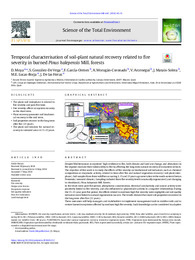Por favor, use este identificador para citar o enlazar este ítem:
https://hdl.handle.net/11000/6284Registro completo de metadatos
| Campo DC | Valor | Lengua/Idioma |
|---|---|---|
| dc.contributor.author | Moya, D. | - |
| dc.contributor.author | González De Vega, S. | - |
| dc.contributor.author | García Orenes, Fuensanta | - |
| dc.contributor.author | Morugán Coronado, Alicia | - |
| dc.contributor.author | ARCENEGUI, VICTORIA | - |
| dc.contributor.author | Mataix Solera, Jorge | - |
| dc.contributor.author | Lucas Borja, M.E. | - |
| dc.contributor.author | De las Heras, J. | - |
| dc.contributor.other | Departamentos de la UMH::Agroquímica y Medio Ambiente | es |
| dc.date.accessioned | 2020-09-03T09:50:45Z | - |
| dc.date.available | 2020-09-03T09:50:45Z | - |
| dc.date.created | 2018-05-29 | - |
| dc.date.issued | 2020-09-03 | - |
| dc.identifier.issn | 0048-9697 | - |
| dc.identifier.issn | 1879-1026 | - |
| dc.identifier.uri | http://hdl.handle.net/11000/6284 | - |
| dc.description.abstract | Despite Mediterranean ecosystems' high resilience to fire, both climate and land use change, and alterations in fire regimes increase their vulnerability to fire by affecting the long-term natural recovery of ecosystem services. The objective of this work is to study the effects of fire severity on biochemical soil indicators, such as chemical composition or enzymatic activity, related to time after fire and natural vegetation recovery (soil-plant interphase). Soil samples from three wildfires occurring 3, 15 and 21 years ago were taken in the south-eastern Iberian Peninsula (semiarid climate). Sampling included three fire severity levels in naturally regenerated (and changing to shrublands) Pinus halepensis Mill. forests. In the short-term post-fire period, phosphorus concentration, electrical conductivity and urease activity were positively linked to fire severity, and also influenced β-glucosidade activity in a negative relationship. During the 15–21-year post-fire period, the effects related to medium-high fire severity were negligible and soil quality indicators were linked to natural regeneration success. The results showed that most soil properties recovered in the long term after fire (21 years). These outcomes will help managers and stakeholders to implement management tools to stabilise soils and to restore burned ecosystems affected by medium-high fire severity. Such knowledge can be considered in adaptive forest management to reduce the negative effects of wildfires and desertification, and to improve the resilience of vulnerable ecosystems in a global change scenario. | es |
| dc.description.sponsorship | This study was supported by a grant for research initiation provided by the Excma. Diputación Albacete (DIPU4-AB2015) and by the funds provided by University Castilla-La Mancha to the Forest Ecology Research Group. | - |
| dc.description.sponsorship | The authors with to thank the Spanish Institute for Agricultural and Food Research and Technology (INIA) for the funding awarded through National Research Projects GEPRIF (RTA2014-00011-C06). | - |
| dc.format | application/pdf | es |
| dc.format.extent | 10 | es |
| dc.language.iso | eng | es |
| dc.rights | info:eu-repo/semantics/openAccess | es |
| dc.subject | Fire severity | es |
| dc.subject | Aleppo pine forests | es |
| dc.subject | Ecosystem response | es |
| dc.subject | Soil quality indicators | es |
| dc.subject | Post-fire restoration | es |
| dc.subject | Land management | es |
| dc.subject.other | 504 - Ciencias del medio ambiente | es |
| dc.title | Temporal characterisation of soil-plant natural recovery related to fire severity in burned Pinus halepensis Mill. forests | es |
| dc.type | info:eu-repo/semantics/article | es |
| dc.identifier.doi | 10.1016/j.scitotenv.2018.05.212 | - |
| dc.relation.publisherversion | https://doi.org/10.1016/j.scitotenv.2018.05.212 | - |

Ver/Abrir:
5-Moya et al. STOTEN 2018.pdf
1,96 MB
Adobe PDF
Compartir:
 La licencia se describe como: Atribución-NonComercial-NoDerivada 4.0 Internacional.
La licencia se describe como: Atribución-NonComercial-NoDerivada 4.0 Internacional.
.png)